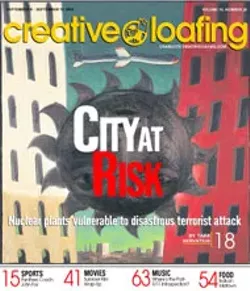City At Risk
Area nuclear plants... vulnerable to disastrous terrorist attack
Page 4 of 5
"Many of the spent fuel pools have six times as much fuel as the reactor," said Lochbaum. "It will have to cool for 10,000 years. It is a hazard in the reactor, and it is a hazard elsewhere."
An October 2000 NRC study of spent fuel pool accident risk found that half the commercial airplanes flying today could likely penetrate the reinforced concrete walls around the spent fuel pools and compromise the support and containment systems, causing coolant to drain out and the irradiated fuel to be uncovered. The uncovered fuel could catch fire with disastrous results, even years after its removal from the reactor core, the report said.
Where does the spent fuel come from and what is it? In a nuclear reactor, enriched uranium fills metal fuel rods that are grouped into fuel assemblies. After the fission of uranium generates heat and the fuel is spent, the radioactive assembly, the heart of the reactor, must be stored and cooled in water. McGuire has 2,152 of these assemblies stored in its fuel pools. Catawba has 1,780. These assemblies contain one of the nation's most lethal sources of radiation, second only to that found in the core of nuclear reactors, where the spent fuel originates.
Unlike the nuclear reactor containment buildings, which have seven reinforced layers of protection between the core and the outside world, the lethal radiation in spent fuel pools at Catawba and McGuire is protected by only two feet of reinforced concrete and another two feet within the pool itself, which is located just below ground level.
"The NRC has never tested the security of spent fuel storage," Lochbaum said. "Since 1991, the NRC has been focusing security testing on the security of the reactor. They have exercises with a small band of intruders and see how well the security holds up. Every one of them had the reactor as the target. Not one of them tested the spent fuel. While there are gates and alarms, no one has ever tested them. We can't see that there aren't seams or gaps someone might want to exploit. We think security needs to be beefed up."
It's not just the strength of the reactor or the spent fuel pools that most worries Lochbaum. He believes that terrorists might also attempt to attack the plant's control room. Debate over whether McGuire and Catawba's control rooms would be functional after an attack is inconclusive. Nuclear scientists like Lochbaum and Lyman say the plants' control rooms are vulnerable because they are located outside the reactor and because the plants' control rooms weren't designed to withstand the impact of large explosions of a jet. Duke Energy's Pettit points out that if the control room is hit, a backup safe shutdown facility exists, in addition to a third set of electrical panels with switches like breakers that could be used to manually shut down the reactor in the event of an emergency. Pettit said that even if the control room operators were killed in an attack, the plant could call in other operators who work different shifts or make use of control room operators who work outside the control room. But again, Lochbaum argues, that assumes a slow enough leak of dangerous materials that new operators could be brought in before it became serious.
"If they are responding to a terrorist attack, they may only have a few minutes, or, depending on the damage involved, the operators may not be able to get to the control panels," he said.
In Everyone's BackyardThe nuclear safety debate is both local and national at the same time. That's because nuclear radiation doesn't recognize the 10-mile zone around the plant where most evacuation plans stop, says Paul Gunter, director of the Reactor Watchdog Project for Nuclear Information and Resource Service in Washington, DC.
"If there is a catastrophic release, it will be borne on the wind for hundreds, if not thousands of miles," said Gunter. "If it is raining, you'll get very high concentrations closer in to the plant about 50 to 100 miles. There are still farms in Cumbria, England, that have restrictions on human consumption of lamb because the spring grasses are bringing up Cesium 137 from the Chernobyl power plant meltdown in the Ukraine."
Counter-terrorism expert Tom Bevan, Director of Homeland Defense at Georgia Tech, spent years studying the fallout from the Chernobyl accident. He says that although the technology used at the nuclear plant at Chernobyl is different than that used in the US today, the potential results of a radioactive fire on the area surrounding a nuclear plant remain the same.
"If a reactor catches fire from a load of airplane fuel, then things will go in the atmosphere and spread around," said Bevan. "It's not a clean nuclear reaction [such as those] the military studies when they plan how they would respond to these things."
Speaking of News_.html, 5.00000
-
A Family Affair
Dec 12, 2007 -

Darrell Roach
Dec 12, 2007 -
Body Talk
Dec 12, 2007 - More »
Latest in Cover
Calendar
-

Queen City Mimosa Festival & Day Party @ Blush CLT
-

Queen City Tequila Festival @ Blush CLT
-

Coveted Luxury Watches
-

TheDiscountCodes
-

Celebrate AAPI Food, Culture, & More at Panda Fest Charlotte! @ Ballantyne’s Backyard










